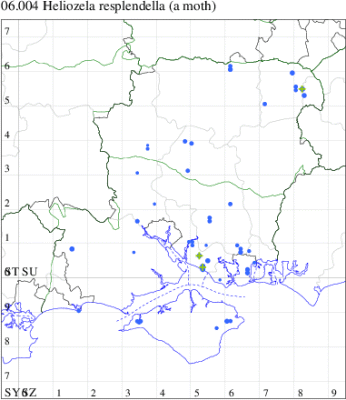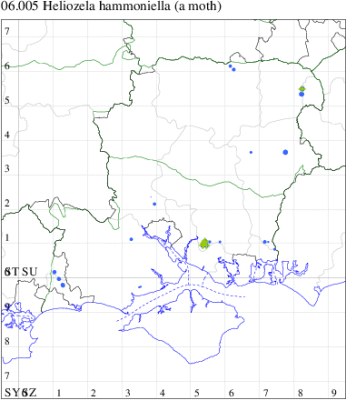2023 Annual Report for: Heliozelidae / Heliozelinae
For species seen in 2023 that had less than or equal to 100 records, full details are included; for more common species, the earliest, latest and highest count by vice-county are shown. The narrative for each species is taken from the main Hantsmoths website, and it is possible that some information on abundance and occurrence can get out of date, as it is impossible to keep up with all changes; however it should give a good introduction to each species. The tables in each species account summarise the previous status, and that for the current year.
For the maps, all records prior to 2023 are shown by a blue dot (the larger the dot, the more recent), with the current year's records shown in red. As previous records are superimposed on any report for 2023, new sites have greater emphasis (i.e. will show as 'more red').
In the species accounts, an asterisk next to a location indicates a new 10km square record; earliest ever dates are highlighted in orange, and latest ever in red. Initials in the species accounts refer to the recorders listed here. Please get in touch if you identify any omissions or errors, in particular if you have records that have yet to be submitted. Details of how to submit records can be found here.
06.001 [B&F: 0158] Antispila metallella ([Denis & Schiffermüller], 1775) - Local
Local in woodland, and on downland and scrubland throughout much of England. In Hampshire and on the Isle of Wight reasonably common and well-distributed on the chalk. Wingspan 7.5-8.5 mm. Adults are day-flying, but the species is more frequently recorded in the larval stage, mining the leaves of Dogwood Cornus sanguinea. The mine starts as a short gallery along leaf edge, abruptly changing to a blotch, finally the larva cuts out an oval hole 5.5 to 7mm along the longer axis. Before the egg is laid the female makes several ‘practice’ slits, which helps to separate this from Antispila petryi.
Records prior to 2023
| Vice County | #Records | #Individuals | First Record | Last Record |
|---|---|---|---|---|
| 10 | 37 | 13 | 1900 | 2019 |
| 11 | 44 | 36 | 1974 | 2021 |
| 12 | 32 | 19 | 1971 | 2020 |
2023 records
| Vice County | #Records | #Individuals | Max Quantity |
|---|---|---|---|
| 11 | 1 | 5 | 5 |

Records by year
Records by week (adult)
Records by week (larval)
Record Details
VC11: Stubbington, vacated mine, five, 25 Aug (DPH)
06.002 [B&F: 0159] Antispila petryi Martini, 1899 - Local
Local in woodland, and on downland and scrubland throughout southern England, north to Yorkshire. In Hampshire and on the Isle of Wight not uncommon where the foodplant grows, recorded mostly as vacated mines and leaf cut-outs. Wingspan 6 mm. May be separated from the other Cornus feeding Antispila A. metallella by its smaller size, darker and less coppery ground colour, the shape of the pre-apical spot, the colour pattern of the terminal cilia and the paler and less purple hindwings (MBGBI Vol 1). Larva mines leaves of Dogwood, subsequently living within a movable case, and over-wintering as a pupa. The mines are described in the following link:
leafmines.co.uk
.
Van Nieukerken et al (Nota Lepidopterologica 41, 2018) documented that the Cornus feeding Antispila species was in fact A. petryi (not previously on the British List) and not A. treitschkiella as previously assigned; therefore all historic records of A. treitschkiella have now been reassigned to petryi. True Antispila treitschkiella has only been found in the UK in London (2016). It feeds on Cornelian Cherry (Cornus mas) and has two generations a year.
The forewing costal spot is usually triangular in treitschkiella, whereas it is trapezoid in petryi, but the two are best distinguished by male genitalia, larva and hostplant.
Leaf-mines can be found in August to October, the larva eating out a short gallery leading to a blotch, then cutting an oval case.
Link to article on the discovery of A. treitschkiella in Britain
Reference:van Nieukerken, Lees, Doorenweerd, Koster, Bryner, Schreurs, Martijn, Timmermans, Sattler (2018), Two European Cornus L. feeding leafmining moths, Antispila petryi Martini, 1899, sp. rev. and A. treitschkiella (Fischer von Raslerstamm, 1843) (Lepidoptera, Heliozelidae): an unjustified synonymy and overlooked range expansion, Nota Lepi. 41(1) 2018: 398.
Records prior to 2023
| Vice County | #Records | #Individuals | First Record | Last Record |
|---|---|---|---|---|
| 10 | 36 | 12 | 1918 | 2022 |
| 11 | 54 | 36 | 1976 | 2021 |
| 12 | 26 | 31 | 1940 | 2019 |
2023 records
| Vice County | #Records | #Individuals | Max Quantity |
|---|---|---|---|
| 11 | 1 | 1 | 1 |
Records by year
Records by week (adult)
Records by week (larval)
Record Details
VC11: Tipner Park & Ride, Portsmouth, vacated mine, one, 30 Jul (AMD)
06.004 [B&F: 0156] Heliozela resplendella (Stainton, 1851) - Local
Local on fens, marshes and river-banks in Britain, as far north as Perthshire. Probably under-recorded in Hampshire, where the extent of known records correlate with those areas in which the recording effort is concentrated; distinctly uncommon on the Isle of Wight. Wingspan 5-7 mm. Adults are day-flying, and the species is more frequently recorded in the larval stage, when mines are relatively easy to find where they are present. Larva mines leaves of Alder, over-wintering as a pupa. The mines are described in the following link:
leafmines.co.uk
.
Records prior to 2023
| Vice County | #Records | #Individuals | First Record | Last Record |
|---|---|---|---|---|
| 10 | 9 | 3 | 1926 | 2020 |
| 11 | 49 | 32 | 1982 | 2022 |
| 12 | 15 | 115 | 1981 | 2022 |
2023 records
| Vice County | #Records | #Individuals | Max Quantity |
|---|---|---|---|
| 11 | 3 | 13 | 12 |
| 12 | 2 | 11 | 10 |

Records by year
Records by week (adult)
Records by week (larval)
Record Details
VC11: Blashford Lakes HIWWT NR*, mine, present, alnus glutinosa, 14 Oct (JOug); Titchfield Haven NNR, vacated mine, one, mine and cut-out on alder. , 19 Aug; Fareham, vacated mine, 12, 25 Aug (DPH);
VC12: Castle Bottom NNR, vacated mine, one, 26 Aug (AMD); Fleet Pond, mine, 10, mines abundant on alder, 25 Aug (MHals)
06.005 [B&F: 0157] Heliozela hammoniella Sorhagen, 1885 - Local
Local on heathland, scrubland and fens in Britain as far north as the Lake District. In Hampshire and on the Isle of Wight restricted to a handful of sites, mainly in the south of the county, notably Botley Wood and Emer Bog, and very rare in the north and on the Island. Wingspan 5-7 mm. Adults are day-flying, and the species is more frequently recorded in the larval stage, when mines are relatively easy to find where they are present. Larva mines twigs and leaves of Birch, over-wintering as a pupa. The mines are described in the following link:
leafmines.co.uk
.
Records prior to 2023
| Vice County | #Records | #Individuals | First Record | Last Record |
|---|---|---|---|---|
| 10 | 6 | 0 | 1977 | 1977 |
| 11 | 34 | 21 | 1981 | 2022 |
| 12 | 7 | 52 | 2001 | 2022 |
2023 records
| Vice County | #Records | #Individuals | Max Quantity |
|---|---|---|---|
| 12 | 1 | 1 | 1 |

Records by year
Records by week (adult)
Records by week (larval)
Record Details
VC12: Shortheath Common, Oakhanger*, vacated mine, one, 06 Aug (AMD)
